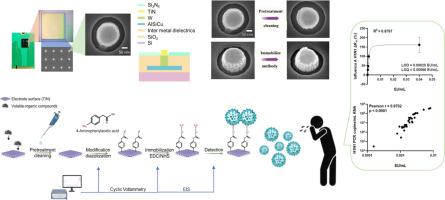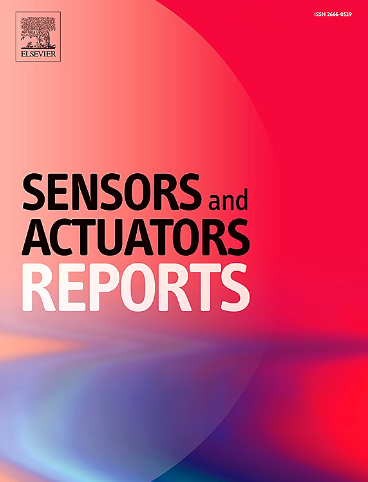A novel impedimetric biosensor based on titanium nitride nano-electrode arrays for influenza A H1N1 testing
IF 7.6
Q1 BIOTECHNOLOGY & APPLIED MICROBIOLOGY
引用次数: 0
Abstract
The development of point-of-care testing devices for real-time detection of influenza A H1N1 virus is critical for early diagnosis, and for continuous disease monitoring. In this study, we developed a novel impedimetric biosensor for detecting influenza A H1N1 virus, using a nano-electrode array fabricated through standard complementary metal-oxide-semiconductor technology. Each nano-electrode is a raised structure with a radius of 100 nanometers and a height of 200 nanometers. Titanium nitride was chosen as the electrode material for its biocompatibility and compatibility with semiconductor processes. The electrode surfaces were modified by diazonium electrografting to introduce carboxyl groups, which enabled antibody immobilization via carbodiimide coupling chemistry. We analyzed the relationship between the reduction peak current and the percentage change in charge transfer resistance before and after each modification step, and further examined the correlation between changes during modification and antibody binding. The completed biosensor successfully detected influenza A H1N1 antigens in phosphate-buffered saline, achieving a detection limit of 0.00025 EU/mL. The sensor’s response also showed a strong positive correlation with viral RNA content (Pearson r = 0.9702), indicating its potential for quantitative virus detection. These results demonstrate the feasibility of using semiconductor-based nano-electrode array biosensors for point-of-care infectious disease diagnostics.

基于氮化钛纳米电极阵列的新型抗阻生物传感器用于甲型H1N1流感检测
开发实时检测甲型H1N1流感病毒的即时护理检测设备对于早期诊断和持续疾病监测至关重要。在这项研究中,我们开发了一种新型的阻抗生物传感器,用于检测甲型H1N1流感病毒,该传感器使用了通过标准互补金属氧化物半导体技术制造的纳米电极阵列。每个纳米电极是一个半径为100纳米,高度为200纳米的凸起结构。选择氮化钛作为电极材料是因为其具有生物相容性和与半导体工艺的相容性。电极表面通过重氮电接枝修饰引入羧基,从而通过碳二亚胺偶联化学实现抗体的固定化。我们分析了每个修饰步骤前后的还原峰电流与电荷转移电阻百分比变化的关系,并进一步检验了修饰过程中的变化与抗体结合的相关性。完成的生物传感器成功检测了磷酸盐缓冲盐水中的甲型H1N1流感抗原,检测限为0.00025 EU/mL。该传感器的响应也与病毒RNA含量呈强正相关(Pearson r = 0.9702),表明其具有定量检测病毒的潜力。这些结果证明了使用半导体纳米电极阵列生物传感器进行即时传染病诊断的可行性。
本文章由计算机程序翻译,如有差异,请以英文原文为准。
求助全文
约1分钟内获得全文
求助全文
来源期刊

Sensors and Actuators Reports
Multiple-
CiteScore
9.60
自引率
0.00%
发文量
60
审稿时长
49 days
期刊介绍:
Sensors and Actuators Reports is a peer-reviewed open access journal launched out from the Sensors and Actuators journal family. Sensors and Actuators Reports is dedicated to publishing new and original works in the field of all type of sensors and actuators, including bio-, chemical-, physical-, and nano- sensors and actuators, which demonstrates significant progress beyond the current state of the art. The journal regularly publishes original research papers, reviews, and short communications.
For research papers and short communications, the journal aims to publish the new and original work supported by experimental results and as such purely theoretical works are not accepted.
 求助内容:
求助内容: 应助结果提醒方式:
应助结果提醒方式:


